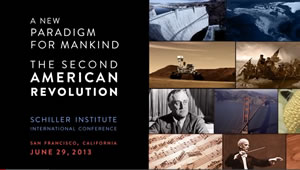 |
NEW WEBSITE: FORUM FOR A NEW PARADIGM
The U.S. and China: Natural Allies
For Justice, Peace, and Prosperity
by Wenji Victor Chang
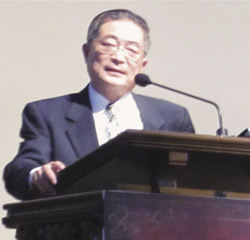 EIRNS/Daniel Platt
Dr. Wenji Victor Chang. |
[This transcript in PDF format, from EIR]
Dr. Chang, of the Institute of Sino Strategic Studies in Whittier, Calif., gave this speech to the San Francisco Schiller Institute conference on June 29.
The world is entering a critical transitional and defining moment, as the 2007-2009 financial crisis has painfully demonstrated. The political and economic systems, which have been dominated by financial oligarchs over the last several hundred years, have failed all peoples around the world, and need to be changed. Therefore, I am pleased and honored to be invited to this important conference, “The Second American Revolution and A New Paradigm for Mankind,” sponsored by the Schiller Institute.
Time and again, Friedrich Schiller’s dramas demonstrate how a person’s duty lies above his or her own personal inclinations; how he or she must be both a patriot and a world citizen. For the true interests of any one nation can never be at odds with the interests of the world as a whole. It is in this spirit that his teaching is so relevant to our attempt to establish a new paradigm.
Any rational person would agree that to overcome the ongoing financial and economic crisis requires constructive partnerships among countries and peoples in this global village. However, the world has become even more unstable since the 2008 financial crisis. Political upheavals have spread to every continent, from Africa to America. Why? It is because of increasing polarization in wealth distribution among countries and among citizens in individual countries.
Tensions even flared in East Asia, a relatively calm region before 2008. Part of the reason is the highly vocal announcement of rebalancing of the U.S. military forces: 60% of the maritime forces will be deployed to Asia.
As an American, originally from the region, I totally agree that Asia is of great importance to the future well-being of this country. However, is destabilizing the region really serving the interests of this country, really serving the interests of Asian countries, and really serving the interests of the whole world? Of course, the answer to most of the rational people is a resounding no. So why did our policymakers do this?
As pointed out by Lyndon [LaRouche], Helga [Zepp-LaRouche], and many scholars here, the source of the troubles is the financial oligarchs who have betrayed the U.S. Constitution, and have gradually taken control of U.S. politics since 1913, when the Federal Reserve was established. In this speech, I will mainly focus on why the U.S. and China are natural allies, and how to strengthen this strategic relationship.
The U.S. and China: Converging Interests
As remarked by former Secretary of State Hillary Clinton on March 7, 2012, the U.S.-China relationship is unprecedented in the history of nations. The United States is attempting to work with a rising power to foster its rise as an active contributor to global security, stability, and prosperity, while also sustaining and securing American leadership in a changing world. The two countries are, together, building a model in which both countries strike a stable and mutually acceptable balance between cooperation and competition. This is uncharted territory. And we have to get it right, because so much depends on it.
Needless to say, there are many differences between the two political and economic systems, two cultural and historical experiences. One of them is the U.S. trade deficit with China of $300 billion a year, which needs to be addressed in a constructive manner, and not degenerate into finger-pointing matches.
However, there are many converging interests between the U.S. and China. Let me name a few:
• Both countries need a peaceful and stable international environment.
• Both countries have become thoroughly, inescapably interdependent.
• Both countries, or at least most people in both countries, are committed to building a cooperative partnership based on mutual benefit and mutual respect.
• Both countries are looking for a win-win relationship, instead of a zero-sum game.
• Both countries are facing increasing polarization of wealth distribution in their respective societies. The citizens of this country need to take back our government from the hands of financial oligarchs. China needs to get rid of crony capitalism.
China and the United States cannot solve all the problems of the world, but without our cooperation, it is doubtful any problem can be solved.
There are also many similarities between the two countries:
• Their size is uncannily close, with each occupying almost exactly 6.5% of the world’s landmass.
• Both are multi-national states.
• Both are religiously tolerant countries, contrary to many smear campaigns against China. If you look at Chinese history, one thing stands out: that is, in her more than 4,000 years of history, there never was a religious war. Even Communist China, in recent years, is actually very tolerant toward different religions, as long as the religious groups are not using religion as a cover to engage in subversion and certain illegal activities.
Most importantly, Chinese and Americans share the same deepest beliefs and desires in our heart and soul, as shown by the similarities between the teachings of American Founding Fathers and the teachings of ancient Chinese philosophers and Chinese leaders of modern times. It is in this sense that the U.S. and China are natural allies.
Therefore, I shall discuss these shared values in the remainder of my presentation.
The People-First Principle
The founding principle of the U.S. is best expressed in the Preamble to the Constitution. The basic idea is to “promote the general Welfare,” and “secure the Blessings of Liberty to ourselves and our Posterity.” Our government, as envisioned by our Founding Fathers, is a “government of the people, by the people, for the people,” as eloquently presented by President Abraham Lincoln in his famous Gettysburg Address. This idea greatly influenced Chinese leaders of modern times such as Dr. Sun Yat-sen, Chiang Kai-shek, Mao Zedong, Zhou Enlai, Deng Xiao-ping, Jiang Zemin, etc.
This people-first principle is also the deepest belief in the Chinese heart and soul, as reflected in the teachings of ancient Chinese scholars.
|
FIGURE 1 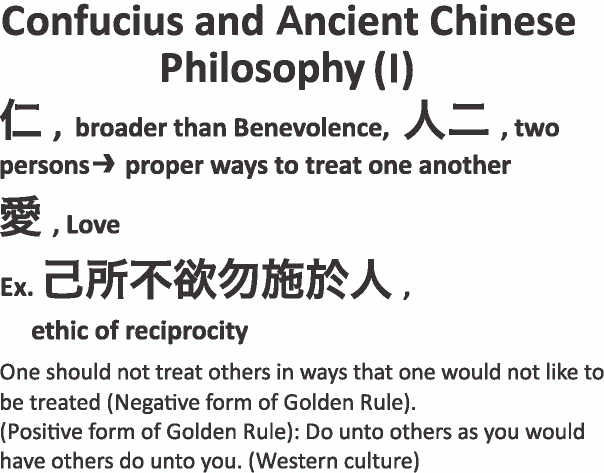 |
The most important concepts of Confucius and ancient Chinese philosophy can be expressed in terms of several simple Chinese characters. As this slide shows, the first core concept is commonly translated as “benevolence” (Figure 1). But actually its meaning is much deeper and richer than benevolence. As you can see, this character consists of two parts. The left part, which looks like a human, is the Chinese character for “person.” The right part, I think you all can figure it out, is the Chinese character for “two.” Figuratively, this character means two persons, which is extended to mean the proper way to treat one another.
In a more concrete way, the starting point of benevolence is love. One needs to love your friends, love persons around you. How do we exercise love? Confucius taught us that we need to practice the Chinese ethic of reciprocity, which translated into English is, “One should not treat others in ways that one would not like to be treated.” This is the negative form of the Golden Rule. Most western cultures adopt the positive form of the Golden Rule: “Do unto others as you would have others do unto you.” This slight difference between the two cultures has a profound effect on the thinking of the two peoples.
|
FIGURE 2 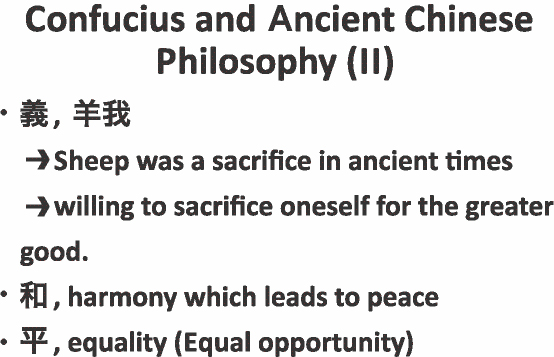 |
This slide summarizes the next few core concepts. The first character (Figure 2) means that you would sacrifice yourself for the greater good of the society and the whole world. This Chinese character consists of two parts. The first (or upper) part is sheep. Sheep served as a sacrifice in ancient times. Sacrifice for what? For the greater good of your group. The second (or lower) part is “I” or “me.” In other words, you are willing to act as a sheep for the greater good of the society. This is a very important value in traditional Chinese culture. The next concept is harmony. You always seek for harmony, be it in music or in other things, and try to avoid going to extremes. The last character is equality and equal opportunity. If you combine the last two, you have the character which is translated into English as “peace.” In other words, in the Chinese mind, a lasting peace can only be built upon harmony and equality.
Conscience for Heaven and Earth
|
FIGURE 3 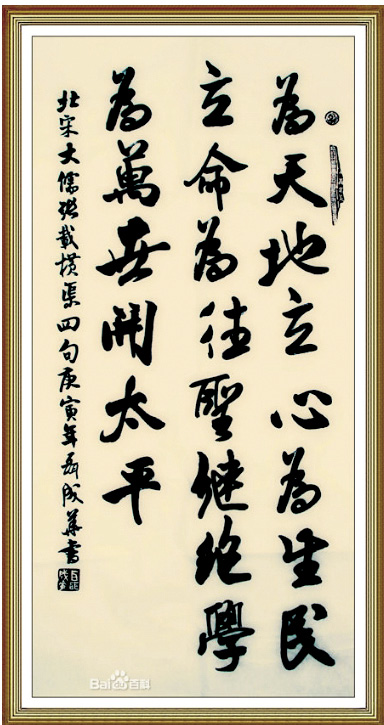 |
This slide shows a beautiful Chinese calligraphy of a motto treasured by generations of Chinese Classical scholars (Figure 3). I shall explain the meaning of this motto. It consists of four parts, and I shall take the liberty to make a translation (Figure 4).
|
FIGURE 4 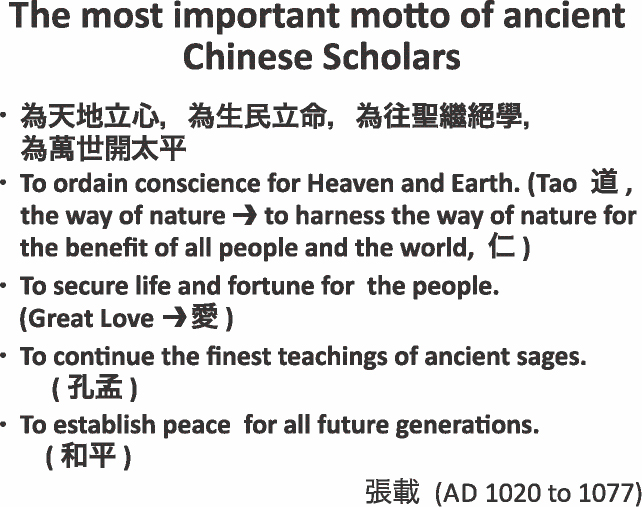 |
The first part is to ordain conscience for Heaven and Earth. How can one do that? According to Chinese philosophy, Tao is the way of nature, and you might have heard about that. As a scholar, you need to harness the way of nature (Tao) in order to bring benefits to all the people and the world. Next is the conscience for Heaven and Earth. For example, you observe the motion of Sun and its relations with the change of seasons, which can be harnessed to benefit people. This naturally leads to the second part, which is to secure life and fortune for the people. This is the great Love.
The third part is to continue the finest teachings of the ancient sages, such as Confucius, Mencius, and others. For what purposes? This is the last part: to establish peace for all future generations.
This is the most important motto for Chinese traditional scholars. And in my view, the Chinese values, as reflected in this motto, are consistent with the teachings of our Founding Fathers and the teachings of Schiller. Therefore, I believe that the U.S. and China are natural allies, because they share the same deepest values in their heart and soul.
Promote Cooperation
So what can we do in a more practical sense? We should take the ideas as expressed by Lyndon and your group. We should promote cooperation instead of confrontation. We should build our cooperation based on science, technology, and development.
Take Far East Asia as an example. There are many tensions over there: tensions between Russia and Japan, between Japan and China, between North Korea and South Korea, etc. However, if rational people look at the real needs in the region, there really is no conflict in fundamental and long-term interests.
There are many real needs for further development. As mentioned in earlier speeches by different speakers, we should extend NAWAPA to Siberia and the North Asia; we should extend the Eurasian Land-Bridge to the U.S. and the American continent. We need to develop the vast lands of Siberia, Korea, and China, etc. It is based on these new developments that we can create new boundaries and a new spirit.
Another area for cooperation is space exploration. Just several days ago, three astronauts who completed China’s longest manned space mission returned to Earth safely, marking another step forward toward the country’s goal of building a permanent manned space station by the year 2020. The U.S. and Russia were once the pioneers in space exploration. However, in recent years, the U.S. effort has become much reduced. I think, in the future of mankind, lots of opportunities are in space, and maybe our challenges and threats one day may come from space also. I believe, in this difficult financial time, it makes a great sense to pool the resources together to jointly explore outer space.
All the above-mentioned things will help the future of both countries, but the most important thing is to build a cooperative environment. This slide shows the ideal world as envisioned by Confucius and ancient Chinese philosophers, and this is called the Chinese Dream (Figure 5). The dream is to build a world of world of great harmony and equality, a world that belongs to everybody. In my view this dream is also the American dream of the General Welfare as expressed in the Preamble to the U.S. Constitution.
|
FIGURE 5 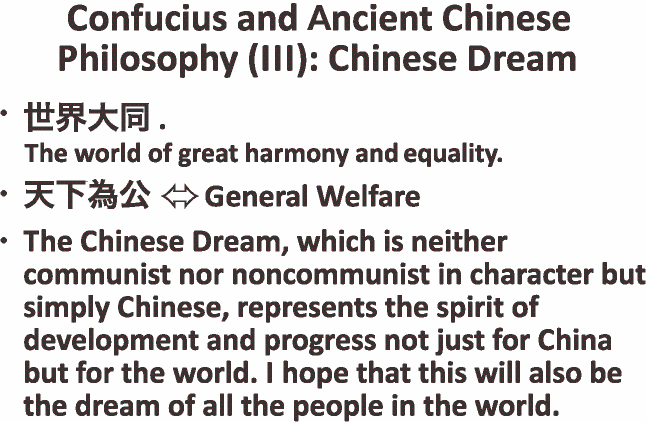 |
The realization of this ideal world is the Chinese Dream, which is neither communist nor non-communist in character, but simply Chinese. It represents the spirit of development and progress, not just for China, but for the world. I hope that this will also be the dream of all the people in the world.
Thank you for your attention.
